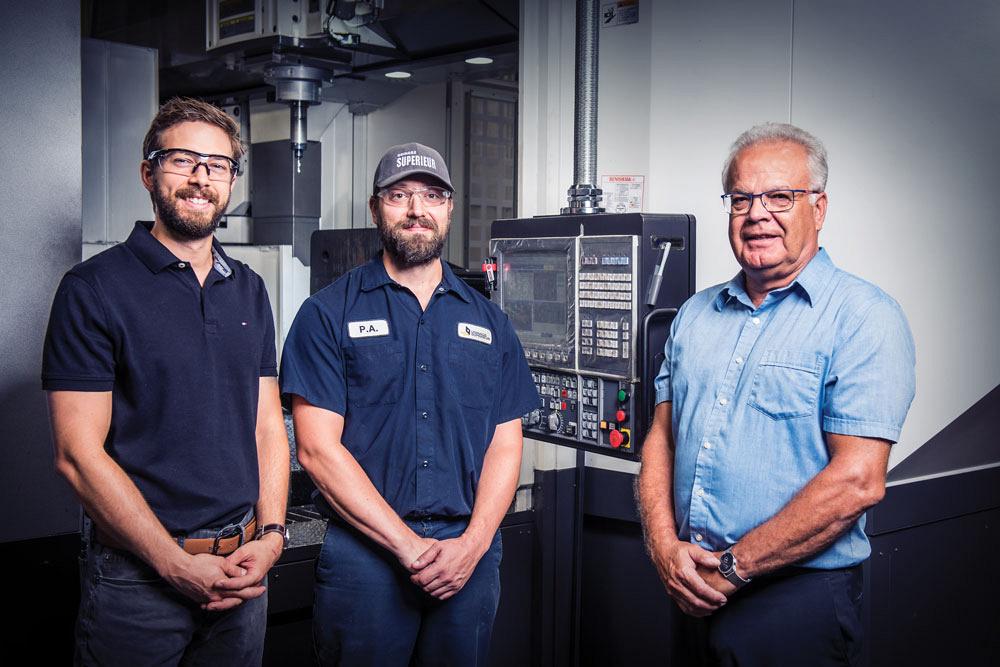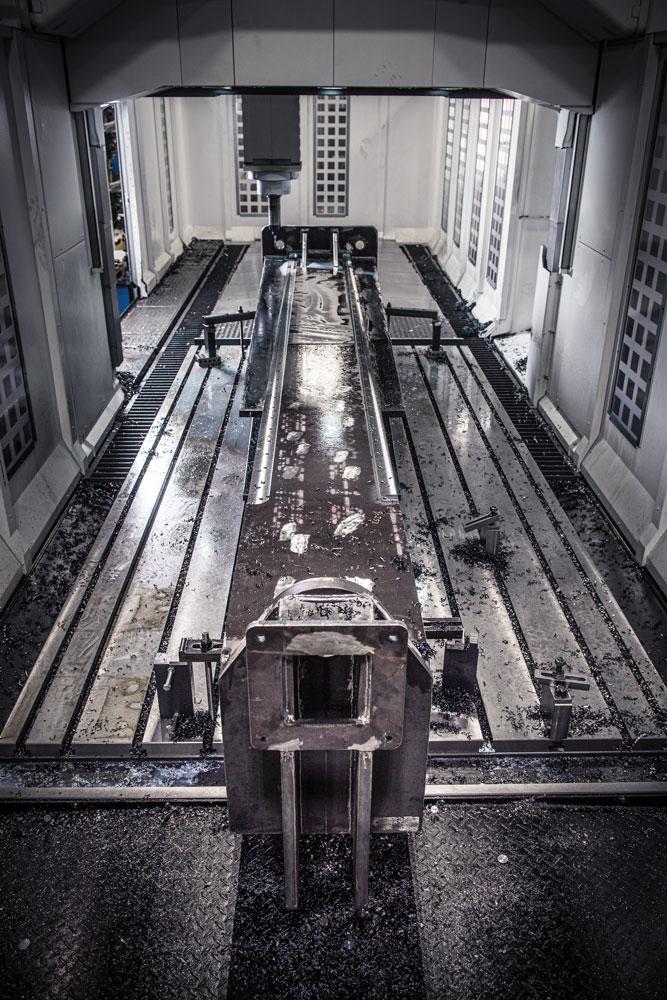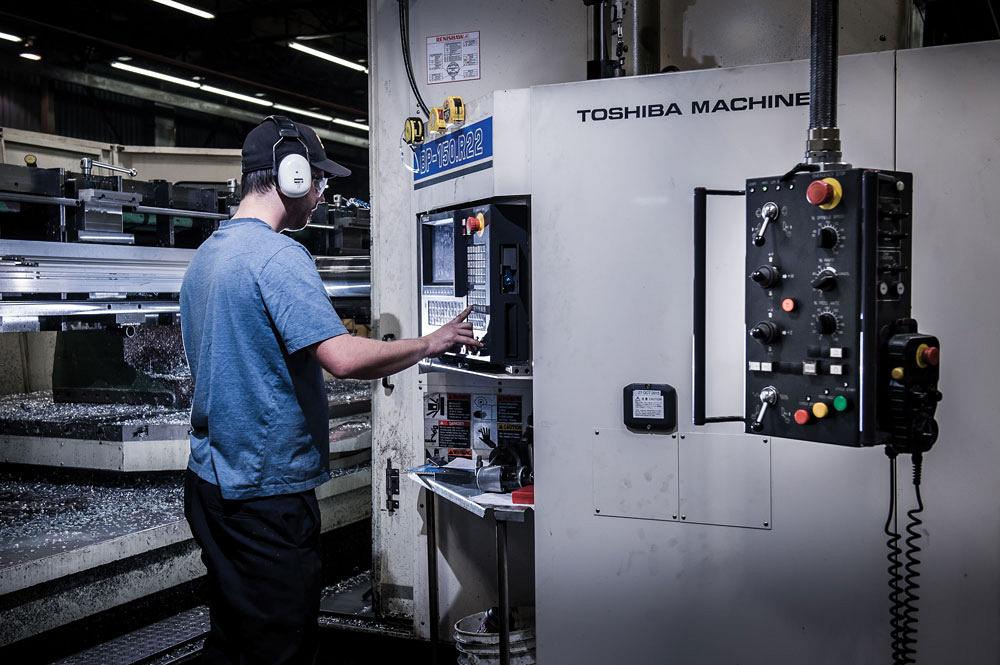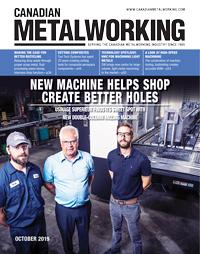Associate Editor
- FMA
- The Fabricator
- FABTECH
- Canadian Metalworking
Making better holes
Montreal-area shop found its sweet spot with a new double-column milling machine
- By Lindsay Luminoso
- November 4, 2019
- Article
- Metalworking
Usinage Superieur, a job shop located in Sainte-Catherine, Que., has spent the better part of the last 34 years perfecting its holemaking abilities. From its beginnings in 1985 as a small repair shop for industrial equipment, the company has grown over the years, expanding its facility and machining capabilities.
“That’s what we primarily do here; we produce holes in tube sheets and structural parts,” said Jean-François Dextraze, operations manager, Usinage Superieur. “To perfect our quality and reduce our downtime, we have developed specific tooling and drilling methods. Holemaking is really our sweet spot.”
The majority of its work comes from the hydroelectric and petrochemical industries, particularly heat exchangers. For much of its recent history, the shop has partnered with Thermofin, a manufacturer of heat exchangers and Usinage Superieur’s largest customer, taking up about 80 per cent of the shop’s capacity. This left the shop with only a limited capacity for other projects and lessened its need to take on additional projects.
However, in recent years the shop has shifted its production whereby Thermofin occupies only about 40 per cent of the capacity, opening up more space for new customers and expanding into new industries. It has even landed some new contracts with the rail transportation industry.
Diversification has allowed the company to better serve both structural and pulp and paper industries as well, which is where the company sees its most promising contracts going forward.
“We are still making heat exchangers, and because of the experience we’ve had with Thermofin, other companies have come to us for their machining needs,” said Dextraze. “We still drill holes for everybody. We drill millions upon millions of holes. But we are also able to weld mechanical structures, mill big surfaces, and bore large diameters.”
Thermofin remains one of the shop’s largest customers, and until recently it also occupied a significant amount of space on Usinage Superieur’s shop floor. This summer the heat exchanger manufacturer decided to move its operations to a new facility close to its headquarters, and not too far from the shop. This has allowed Usinage Superieur to rearrange its 25,000-sq.-ft. shop to create better production flow with its existing lineup of conventional and CNC milling and turning machines. This space also created room for a large Toshiba boring machine; a 2-metre, 5-axis vertical lathe; as well as a new Mitsubishi 9-kW fibre laser.
And despite the fact that its conventional equipment continues to operate after all these years, the company decided to invest in reliable and renowned equipment to support its customer diversification.
NEW EQUIPMENT
Dextraze explained that since the shop is expanding its customer base through diversified equipment, projects and client requirements have become more demanding. Usinage Superieur now can produce bigger heat exchangers and metal structures, which can be a challenge to machine. Operators are required to make holes in upwards of 10-in. plate in difficult-to-machine materials like Hardox® and INCONEL® alloys. The shop was looking to add another machine that would perform these challenging applications quickly and precisely, while still being robust enough for heavy machining. This would help free up other machines for other projects.
“The first CNC machine was purchased in 1994,” said Louis-Charles Rondeau, owner, Usinage Superieur. “It was an Okuma MC-60V milling machine and after more than 74,000 hours on the clock, it’s still running strong.”

(From left) Jean-François Dextraze, operations manager; Pierre-André Bourcier, plant manager; and Louis-Charles Rondeau, owner and CEO, stand in front of the shop’s new Okuma MCR-A5CII double-column machining centre.
For this reason, the company reached out to EMEC Machine Tools Inc. for its latest equipment purchase, a new Okuma MCRA5CII double-column milling machine, one of the first installations of its kind in Quebec.
The MCR-A5CII machine’s table can take parts up to 80 by 160 in., so the shop put it to the test by processing large components for which all five faces needed to be machined. It was able to perform this in one setup, saving the shop time and money
“We needed a machine that even after several years would still have the same repeatability as if it were the first time,” said Dextraze. “We were really impressed with how the boxways allowed the machine to move, as well as its sturdiness. It was also important for us to have local support available.”
Dextraze explained that with the variety of machining options available, whether it’s a 3- to 5-axis machine or lathe, the shop has always been able to grow with its Okuma fleet. And the double-column milling machine is no exception.
“We still had to move a lot of stuff away, but we were able to install it pretty quickly,” said Dextraze. “I think it was a good move for us. Since it’s an Okuma machine, the control board is similar to what we’ve worked with and the components are familiar. It was the logical decision to have this kind of machine here and the learning curve was quick.”
Since the machine has been installed, the shop has put five different operators on it on rotation. Two of the operators were given training on the indexable head, but all five were able to operate the machine with ease. The indexable head function allows the operator to machine on five faces of a part with only one setup, which adds significant efficiency.
“This is where we are seeing the most time savings,” added Dextraze. “The precision and tolerances between the reference face are always respected because we don’t move the part.”
The machine’s table can accept parts up to 80 by 160 in., so the shop put it to the test by processing a 6- by 10-ft. structural component for which all five faces needed to be machined. The double-column was able to perform this in one setup, saving the shop time and money.
The double-column machine is not the only new machine the company has invested in.
It also added an Okuma VTM-2000YB 5-axis lathe in 2018. The shop wanted to incorporate a large vertical lathe that could be used for machining round parts without needing to move to a different machine. Prior to purchasing this new CNC machine, similar parts typically needed to be machined on three different pieces of equipment.

The MCR-A5CII machine’s table can take parts up to 80 by 160 in., so the shop put it to the test by processing large components for which all five faces needed to be machined. It was able to perform this in one setup, saving the shop time and money.
“For example, for big parts, I would have needed to face on our conventional lathe, drill on a 2-3-axis mill, and bore on our Toshiba machine,” said Dextraze. “The VTM offers 5-axis machining, so using the same table I can face, mill, and drill on top. And because the head is a full 5-axis, I can swirl and do any kind of angle machining using the same setup.”
This new machine also allowed the shop to take on 82-in.-diameter projects, where before it was limited to 60-in.-diameter parts.
With all of the new equipment and additional floor space, the shop has been strategic in developing a floor plan that suits its production flow. It has also invested heavily in new tooling, particularly drilling tools for better holemaking.
Adding these new machines has allowed the shop to reach new customers and take on new contracts that it otherwise would not have been able to do, while shortening lead times for existing customers.
“You know, we had worked in the same field for so many years,” said Rondeau. “Once we decided to expand into new fields, we really needed to adapt to different industry requirements. We’ve put in place strong procedures and we continue to invest in training our employees.”
FUTURE OPPORTUNITIES
“Going forward we want to grow and improve while at the same time staying flexible enough to be able to take on requests from a wide range of industrial applications,” said Dextraze. “We already have the equipment in place to do this; we now need to expand our workforce with skilled workers and expand our night shift. We would also like to create serious partnerships to work on our biggest machine.”
The company also is focused on further developing its mechanical assembly and quality department. In the next few months, the shop will be certified to ISO 9001:2015, and welders will have CWB and ASME certification. Dextraze explained that the shop isn’t looking to reach quality certification for industries like aerospace and medical, but it certainly is important to have quality checks in place for industrial applications.
The shop’s new, large-footprint machines have already allowed it to take on jobs that it wouldn’t previously have been able to do. It recently completed 800 pieces of 38-ft. aluminum extrusions for trains in Canada; a 63-ft. steel structure for a federal building in Ottawa; a 10- by 20-ft., 20,000-lb. heat exchanger for a customer in China; along with overhead cranes for hydroelectric dams. For Usinage Superieur, the sky’s the limit.
“Through collaboration, reliability, and continuous improvement, our team is eager to see what the future holds,” said Dextraze.
Associate Editor Lindsay Luminoso can be reached at lluminoso@canadianmetalworking.com.

In 2018 the shop wanted to incorporate a large vertical lathe that could be used to machine round parts, without needing to move to a different machine, so it opted for an Okuma VTM-2000YB 5-axis lathe.
Photos courtesy of Matthieu Lambert.
EMEC Machine Tools Inc., www.emecmt.com
Usinage Superieur, www.usinagesuperieur.com
About the Author

Lindsay Luminoso
1154 Warden Avenue
Toronto, M1R 0A1 Canada
Lindsay Luminoso, associate editor, contributes to both Canadian Metalworking and Canadian Fabricating & Welding. She worked as an associate editor/web editor, at Canadian Metalworking from 2014-2016 and was most recently an associate editor at Design Engineering.
Luminoso has a bachelor of arts from Carleton University, a bachelor of education from Ottawa University, and a graduate certificate in book, magazine, and digital publishing from Centennial College.
Related Companies
subscribe now


Keep up to date with the latest news, events, and technology for all things metal from our pair of monthly magazines written specifically for Canadian manufacturers!
Start Your Free Subscription- Industry Events
MME Winnipeg
- April 30, 2024
- Winnipeg, ON Canada
CTMA Economic Uncertainty: Helping You Navigate Windsor Seminar
- April 30, 2024
- Windsor, ON Canada
CTMA Economic Uncertainty: Helping You Navigate Kitchener Seminar
- May 2, 2024
- Kitchener, ON Canada
Automate 2024
- May 6 - 9, 2024
- Chicago, IL
ANCA Open House
- May 7 - 8, 2024
- Wixom, MI






















